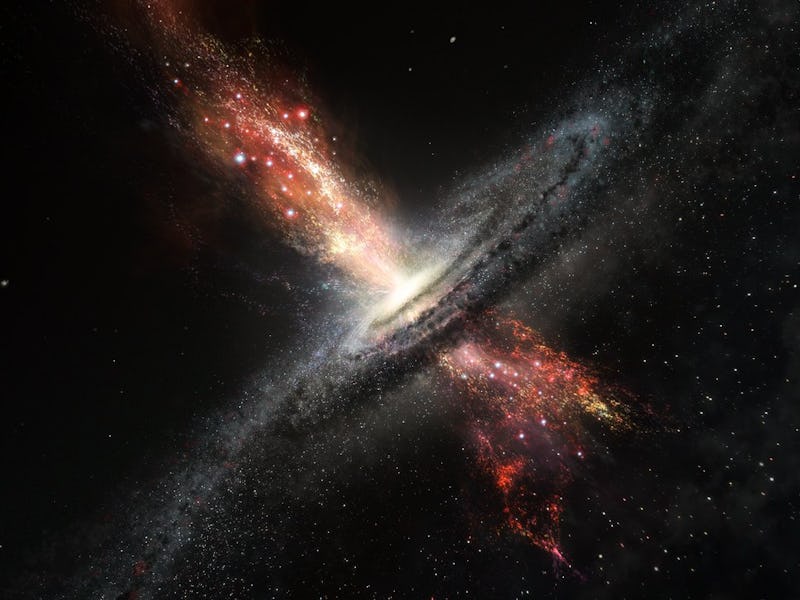Black holes aren’t just terrifying objects of total obliteration — they’re also gross as hell. These behemoths have a strange tendency to yak up some the matter they seemingly crush under an ungodly amount of dense mass. They are one of the most mysterious phenomena in the universe. New observations from the European Southern Observatory’s Very Large Telescope (VLT) illustrate that the biggest bad boys, supermassive black holes, will spit up matter like their smaller brethren. But the messy aftermath might actually lead to formation of new stars.
About 600 million light-years away, there’s an ongoing collision of two galaxies jointly known as IRAS F23128-5919. At the center of the southern galaxy lies a supermassive black hole spitting up a ton of cosmic material. Using the MUSE and X-shooter tools on the VLT at the Paranal Observatory in Chile, scientists found that the outflow of galactic winds from the sheer force of the black hole is stirring up enough cosmic gas and dust to form new stars. This never-before-seen discovery, detailed in a new study published in Nature on Monday, has lead to a slew of new theories about SBHs, including discounting a few old ones.
“Supermassive black holes are a million times larger than classical accretion records,” Roberto Maiolino, an astronomer from the University of Cambridge and the lead author of the new paper, tells Inverse. “Until now, the main theory was that they were connected to destruction; in certain phases these winds are supposed to remove a large amount of material out of the galaxy and suppress the host galaxy.”
But, as Maiolino explains, these new findings show that while supermassive black holes can be the ultimate demise for galaxies, they also can form new stars. In the case of IRAS F23128-5919, these newborn stars are just tens of millions of years old. They also appear to be brighter and hotter than stars formed under regular conditions.
“The dynamic properties of stars produced in the violent and turbulent winds of a supermassive black hole are completely different than stars that were formed within a galaxy,” said Maiolino.
They also found that some of the new stars appear to be held in place by the gravitational pull of the black hole, while others are sent spiraling off into the dark abyss of the universe.
“In some parts of the galaxy the gravitational field is much stronger and in other places the force is weaker,” explains Maiolino. “Depending on where stars form they can have a different fate. So, the stars which form in the injected blast of a black hole very close to the center start circulating around the galaxy, becoming part of what we call the ‘bulge.’ Stars that form far away from the galaxy center achieve a lower force and can actually fly away and leave the galaxy altogether; they can be lost forever.”
Maiolino also theorizes that black holes like the one in the middle of the Milky Way may have a similar history of activity.
“The black hole in the center of our Milky Way is dormant now, but we know it was active in the past and it probably produced similar winds that we are seeing in other galaxies,” Maiolino says. “We know this kind of activity isn’t continuous. [Supermassive black holes] have a large life cycle; they can have an inactive period that could last a few million years and they may be dormant for much longer and then have an active period again. They may have this kind of periodic effect several times.”
There is still much to learn about this new phenomena, but Maiolino and his team are eager to continue their exploration. When the James Webb Space Telescope, the Hubble Space Telescope’s successor, is launched and made operational in October 2018, they hope to find evidence of these active and dormant phases.
“It’s a new field, it’s difficult to assess how frequent it is among galaxies,” Maiolino says. “This can probably only be done with the James Webb Space Telescope, which will have the ability to probe these distant galaxies.”
